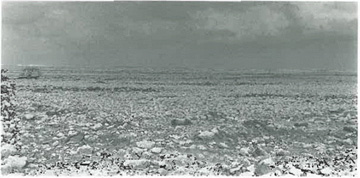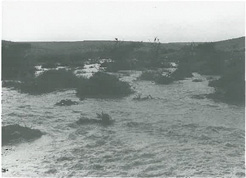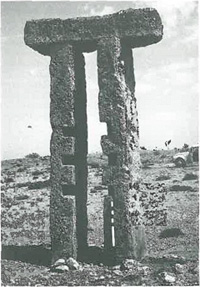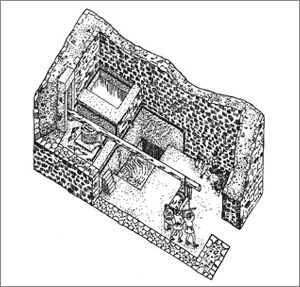Top>Opinion>Farming the Desert: Colonel Qadhafi's Dream
 Index
Index

Masatoshi Miichi [profile]
Farming the Desert: Colonel Qadhafi's Dream
Masatoshi Miichi
Professor, Faculty of Letters, Chuo University; Director, Chuo University Library
Area of Specialization: Western history
Chuo University Library has an International Documents Room, a feature that is rare among Japanese universities. It contains many documents published by various international organizations, including the United Nations. In addition to publicizing this collection of documents, I would like to introduce you to Farming the Desert, a two-volume archaeological survey of Libya published by UNESCO in 1996. The full title of the work is as follows: G. Barker, et al., Farming the Desert: the UNESCO Libyan Valleys Archaeological Survey.
Roman Period Ruins
Ancient Carthage, founded by Phoenicians and centered in present-day Tunisia, prospered before the Common Era. Carthage established three cities referred to collectively as Tripolitania on the Libyan coast of the Mediterranean Sea. One of these cities was Tripoli, the current capital of Libya. Although Carthage was completely defeated by Rome by the end of the three Punic wars, it was rebuilt under Roman rule and, along with Egypt, became one of Rome's most important breadbaskets. Tripolitania also came under Roman rule, and Roman civilization flourished. The Roman ruins of the amphitheater at Sabratha and the city of Leptis Magna are well-known and have been designated as UNESCO World Heritage Sites.
Archaeology for Libyans
Farming the Desert, however, is not a survey of Roman ruins. In the preface, the authors write:
In 1978 the Libyan leader Muammar al Qadhafi had commented in a major public speech that "if archaeology is to be practised at all, then at least let it be relevant to the needs of the people today." He was referring specifically to the need to understand the prolific archaeological traces of ancient settlement visible in the pre-desert.
The pre-desert is an arid region located between the Mediterranean Sea coast and the Sahara Desert. Today it is mostly uninhabited. However, the ruins dotting the region make it easy to imagine the considerable scale on which agriculture was once practiced there. Moreover, those responsible for this system of agriculture were clearly the indigenous people of the land, who were called Libyans by the Greeks and Romans. What Colonel Qadhafi meant was that archaeology in Libya should unearth the past of the Libyan people themselves and contribute to the agricultural development of the country, or policies for "making the desert green." From this we can learn an aspect of Colonel Qadhafi's nationalism that no one examines today.
Following this speech, the Department of Antiquities of Libya turned to UNESCO for assistance, and, as a result, undertook large-scale fieldwork with the help of British and French archaeologists. This book is the report by the Anglo-Libyan team included among these archaeologists.
The Production of Olive Oil
I will now provide a very rough summary of the survey report Farming the Desert. When Libya was a Roman province, olive trees were planted extensively throughout the Libyan pre-desert, and the work of extracting oil from the olives was carried out in the same region. Although olive oil is a basic necessity in the Mediterranean world, it is estimated that the amount of olive oil produced far exceeded the needs of Libyan society at that time, and that a substantial portion of it was for export. Even today, however, the pre-desert is an agricultural frontier that is practically a desert itself, as one can easily imagine from the name. So how did the Libyans secure water back then?
Plateaus rise up in the hinterland of the pre-desert, and when it rains there, the rainwater runs down the slopes into the usually dried-up riverbeds or wadis (Figure 1), transforming them into flooded rivers, as seen in Figure 2. This water was diverted by means of an irrigation system. This method is called water spreading. Members of the upper class, of mixed Phoenician and Libyan descent, living in Tripolitania aggressively invested in the construction of irrigation systems and olive oil mills with the aim to export and sell their goods in international markets. Figure 3 shows a portion of an olive oil press from that time, and Figure 4 is an illustrated reconstruction of the work of oil pressing.

Figure 1: Wadi (dry riverbed)

Figure 2: A flooded wadi

Figure 3: A portion of an olive oil press from that time period

Figure 4: An illustrated reconstruction of the work of olive oil pressing
Source (Figures 1-4): G. Barker, et al., Farming the Desert: the UNESCO Libyan Valleys Archaeological Survey, 1996.
Eventually, however, the Roman Empire fell into crisis, economic activity throughout the Mediterranean started to contract, and olive oil production in the Libyan pre-desert rapidly declined. Most importantly of all, Farming the Desert concludes that the irrigation technology which made agriculture in this arid region economically profitable was originally developed by the Libyans, and that it reached its peak during Roman control and enabled the production of large quantities of olive oil.
Colonel Qadhafi's Dream
As is widely known, Colonel Qadhafi's long dictatorship was supported by Libya's rich oil resources. Moreover, conflict among various Libyan forces over these oil resources and presumably the interests of major international oil companies were involved in his tragic downfall. Oil was also at the center of the large-scale development of Libya's arid inland region during Roman rule. In fact, it was closely tied to globalization at that time. It may be that Colonel Qadhafi entrusted his dream for the Libyan people to develop a robust national economy, which would be firmly rooted in indigenous technology and not be needlessly swayed by global economic trends, to this large-scale archaeological survey.
- Masatoshi Miichi
Professor, Faculty of Letters, Chuo University; Director, Chuo University Library
Area of Specialization: Western history -
[Profile]
Professor Miichi was born in Tokyo in 1946. He graduated from the Faculty of Letters, Tokyo University of Education in 1970. He went on to pursue a doctorate at the Graduate School of Social Sciences, Hitotsubashi University, leaving the program before receiving his degree in 1974. After working as an Assistant at the Institute for Research in Humanities, Kyoto University and an Assistant Professor on the Faculty of Economics, Wakayama University, he became an Assistant Professor on the Faculty of Letters, Chuo University in 1985 and assumed his current position in 1989. He became the Director of Chuo University Library in April 2009. His area of specialization is Western history. -
[Publications]
- Sole-authored Works
-
The World History of Cholera [Korera no Sekaishi], (Shobunsha, 1994);
London: The Global City Created by Fire [Rondon: Honō ga Unda Sekai Toshi], (Kodansha, 1999) - Edited Works
- Reading Modern Britain [Kindai Igirisu wo Yomu], (Hosei University Press, 2011)
- Co-edited Works
-
Blue Terrors, White Cities [Aoi Kyōfu, Shiroi Machi], (Heibonsha, 1990);
The Shape of Memories [Kioku no Katachi], (Kashiwa-shobo, 1999);
Development, Disease and Imperial Medicine [Shippei, Kaihatsu, Teikoku Iryō], (University of Tokyo Press, 2001) - Co-authored Works
-
The Formation of Bourgeois Society in France [Furansu Burujowa Shakai no Seiritsu], (Iwanami Shoten, 1977);
Europe in the 1930s [Yōroppa 1930 Nendai], (Iwanami Shoten, 1980);
The Back Alleys of the British Empire [Rojiura no Daiei Teikoku], (Heibonsha, 1982);
Studies on Montesquieu [Montesukyū Kenkyū], (Hakusuisha, 1984);
The State Apparatus and the People [Kokka Sōchi to Minshū], (Minerva Shobo, 1985;
The History of British Socialist Thought [Igirisu Shakai-shugi Shisōshi], (Sanseido, 1986) - Translations
-
The Downing Street Diaries, (Heibonsha, 1990, 1991);
Le Propre et le Sale, (Dobunkan, 1994);
Empire, (Iwanami Shoten, 2003);
The Enlightenment, (Iwanami Shoten, 2004)
- Research Activities as a Member of Research Fellowship for Young Scientists (DC1), Japan Society for the Promotion of Science (JSPS) Shuma Tsurumi
- Important Factors for Innovation in Payment Services Nobuhiko Sugiura
- Beyond the Concepts of Fellow Citizens and Foreigners— To Achieve SDGs Goal 10 “Reduce Inequality Within and Among Countries” Rika Lee
- Diary of Struggles in Cambodia Fumie Fukuoka
- How Can We Measure Learning Ability?
—Analysis of a Competency Self-Assessment Questionnaire— Yu Saito / Yoko Neha - The Making of the Movie Kirakira Megane








